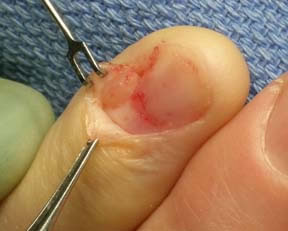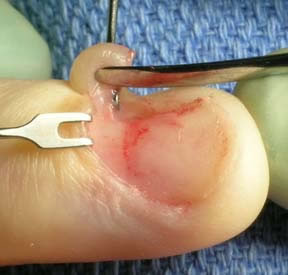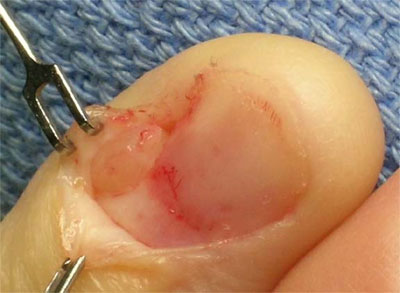Glomus Tumor

The glomus tumor is the white oval mass on the left side of
the nail bed (photo courtesy of Dr. Jose Ortiz)
Glomus tumor is a rare lesion that, in the hand, is usually found growing under the nail. This is called a "subungal" ("under the nail") glomus tumor. They are very painful, especially since they are normally very sensitive to cold exposure or to pressure. A typical patient might state that they have exquisite pain when they hold a glass of icewater, for example. Given the rarity of the tumor, patients often see a number of physicians before they see a hand surgeon, who usually can make the diagnosis rather easily. While the glomus tumor classically occurs under the nail, they can also appear anywhere along the finger or hand.
The cause of the tumor is both interesting and important. Hands are an organ of thermoregulation. In plain English, this means that the body can regulate its temperature by either increasing or decreasing the blood flow to the hands. You probably know, if you go outside into the cold and are beginning to get too cold, your hands get very cold. This is because the body is trying to preserve its warmth by decreasing heat loss through the hands. On the opposite extreme, if you are out on a hot day and are getting too hot, your hands will be very warm and red: your body is trying to lose heat by bringing excess heat to the hands and letting the heat radiate away. Hands, therefore, are an organ that the body uses to help regulate its temperature. Neat, isn't it?
This means that the hands have a special connection between nerves (the body's signalling system) and blood vessels (which can increase or decrease blood flow by increasing or decreasing their diameter). These special connections are called glomus bodies. You can guess, therefore, where the name "glomus tumor" comes from: these glomus bodies sometimes grow inappropriately, causing a glomus tumor. They are benign, which means that they are NOT CANCER, but are usually very painful on exposure to cold.
Diagnosis is usually based on a good history and physical exam. Sometimes an MRI is needed, but usually not.
Treatment is simple surgical excision. By "simple" I mean that it can be done on an outpatient basis (come in, get it done, go home, all on the same day) and that surgical reconstruction is usually not needed. The surgeon can make a small incision and just cut it out. They usually are only 2 to 6 mm in size. The nail plate (the hard thing you cut with a nail clipper; for further information on fingertip anatomy, see the picture on my page on Fingertip Cruch Injuries) usually is in the way and has to be removed, but it grows back in about 4 months. Sometimes, if the glomus tumor is large, some reconstruction of the nail bed may be needed.
Here is a picture of a glomus tumor, from my friend Dr. Thomas Fischer. The glomus tumor is the small, whitish, bumpy mass growing below the nail bed (the pink soft tissue that grows below your nail plate, which is the thing you cut with a fingernail clipper). Recurrence of the tumor is the biggest problem, so it is important for the surgeon to work hard the first time to get it all out. However, as you can see from the picture below, it is hard to tell what is tumor and what is normal finger! Once the tumor is completely removed, the patient does quite well and has no further problems. If the tumor is not completely removed, it can grow back and another surgery may be needed. Nail plate regrowth can be a problem, but is not common.
 |
This is the glomus tumor (the while rounded mass held up by the flat instrument) from the top photograph, removed from the nail bed. (photo courtesy of Dr. Jose Ortiz)
|
 |
| This is a magnified view of the very top photograph. (photo courtesy of Dr. Jose Ortiz) |
My friend, Dr. Charles Eaton, has an excellent article and example of treatment of a glomus tumor.
